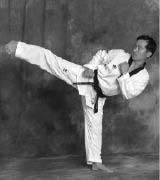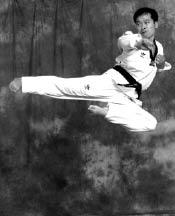Complete Kicking (2 page)
Authors: Turtle Press



arm position
To find the most natural position of your arms and hands, raise your arms higher than your usual fighting stance (photo 1) and slowly lower them until you find the right height (photo 2). Keep your elbows bent and swing your arms around your torso a few times, then stop where you feel most comfortable. Make they cover the vital targets of the torso.


knee control
The knee travels straight forward in front kick, in a circular motion in roundhouse kick, backward in back kick. How you manipulate your knee determines the angle of the kick. You can practice knee control in most of the twelve directions of the clock.

3 kicking essentials
Base
Your two feet form the base for your actions. The ideal base is about shoulder width or a bit wider. Positioning your feet too far apart or too close together creates an unstable base. Next, align your feet according to what type of kick you are planning to perform. For front kick, for instance, turn your feet forward. For side kick, align your feet sideways and parallel to each other. For roundhouse kick, turn your feet about 45°, between the positions of front kick and side kick.

pivot point
Your standing leg becomes a pivot point when you kick. If you do a roundhouse kick with your rear leg, your front leg is the pivot point. If you throw a front leg roundhouse kick, your rear leg is the pivot point. The pivot point plays an important role in kicking. The smoother you pivot, the better. The quicker you pivot, the more powerful your kick will be. The more stable your pivot is, the more precise your kick will be.
impact
Impact results from a high velocity strike, or a low velocity strike with sufficient weight behind it. You can strike a target with your foot, knee, or shin. For effectiveness, your strike should be precise, fast, and penetrating. To further enhance the impact, strive for maximum range of motion of your kicks through stretching and greater focus of your physical and mental energy through proper breathing and yelling (kihap, kiai). Impact is the ultimate goal of kicking.

5 Kicking Stages
ready
Before kicking, confirm that you have a strong base and align your feet according to what type of kick you are planning to use. Keep your arms close to your body in a guarding position and look at your target. Stay light on your feet and ready to move.
shift
Before turning your body, shift your weight to your front leg for a rear leg kick or to your rear leg for a front leg kick. Do not change the height of your head or your facial expression when you shift your weight, because this will reveal your intentions to your opponent. Be calm and move subtly as you initiate your kick.
pivot
Your standing leg becomes a pivot point when you kick. Always pivot on the ball of your foot, raising your heel slightly to facilitate the pivot. As you pivot, chamber your kick by raising your knee into the appropriate position.
kick
Impact results from a high velocity strike, so kick as quickly as you can while maintaining accuracy. Penetrate two to six inches into the target.
repose
Retract your foot and leg swiftly and prepare for the next action, which might be another kick as part of a combination or a defensive reaction to your opponent’s counterattack.

3 power generators
knee
Bending your knee prior to kicking is called chambering. The way you chamber your knee will determine the direction, range of motion and power of your kick. In general, where you point your knee is the direction of the force of your kick. The sharper you bend your knee, the more power you can generate due to a larger range of motion. If your chamber is lazy, your kick will lack power.
hip
The hip is the primary mover of the body and it functions as a central powerhouse for kicking and punching. The muscles and bones of the hip are large and powerful and are the site of your center of gravity. By rotating your hip quickly and powerfully, you propel knee and foot into the target with maximum power. For many kicks, “snapping” your hip also adds to the impact power of your kick.
Your hip is the powerhouse for kicking. It brings all of the elements of your body’s power together and directs your energy to one single point upon impact.

head
The head is a stabilizer. By keeping your head upright, you anchor the alignment of your spine and maintain the pivoting power of the lower body around the central axis of the spine. If you drop your head while kicking, the force of your kick is dispersed, much like an uncoiled spring.
Other books
The Escape by Dean Wesley Smith, Kristine Kathryn Rusch
Tapped (Totaled Book 2) by Grice, Stacey
Holiday by Stanley Middleton
Hinterlands by Isha Dehaven
Brie Discerns Master's Heart (After Graduation, #6) by Red Phoenix
Third Degree by Maggie Barbieri
I Shall Not Hear The Nightingale by Singh, Khushwant
Mr. Miracle (Harlequin Super Romance) by McSparren, Carolyn
The Duke’s Secret Wife by Kate Walker
Improbable Eden by Mary Daheim
